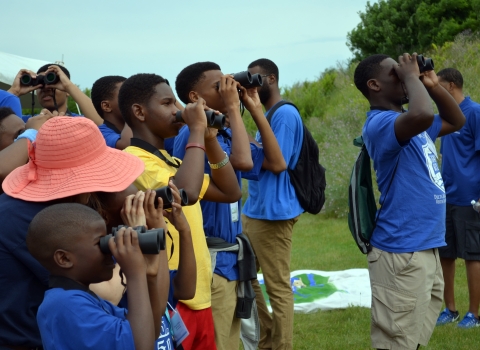The U.S. Fish and Wildlife Service today announced a proposed rule and draft environmental impact statement (EIS) to update 50 year-old regulations governing the management of non-federal oil and gas development on National Wildlife Refuge System lands. The proposed revisions continue to allow for the responsible extraction of oil and gas, but require closer adherence to industry best management practices – especially with respect to abandoned infrastructure and debris.
Private individuals and other entities retain ownership of subsurface minerals on many Service lands, including national wildlife refuges, and have the legal right to develop those resources. The regulations will reduce refuge impacts, including habitat loss and degradation, wildlife mortality and displacement, and other risks to ecological integrity.
“These proposed rule revisions strike an appropriate balance between the rights of owners to develop energy resources with the Service’s critical role in protecting refuges and the fish and wildlife that depend upon them,” said Service Director Dan Ashe. “Refuges are national treasures offering unparalleled opportunities for Americans of all ages, means and backgrounds to hunt, fish, hike, boat and just enjoy being outdoors. We owe it to this and future generations to meet our mission responsibility.”
More than 100 refuges have oil and gas operations, including almost 1,700 actively producing oil and gas wells, and thousands more inactive or plugged wells. While in most instances, impacts on refuge resources are minimal, improperly conducted oil and gas development on refuges can result in significant damage to wildlife and their habitats.
For example, a well blowout 75 years ago at the Aransas National Wildlife Refuge in Texas is still leaking saltwater despite attempts to cap the well, risking contamination to groundwater that is important for whooping cranes and other wildlife during times of drought. In the Lower Rio Grande Valley National Wildlife Refuge in Texas, the growth of invasive plant species due to land disturbance by oil and gas development has increased the risk of wildfire. At Norman Lake Waterfowl Production Area, part of the Crosby Wetland Management District in North Dakota, the heart of the Prairie Pothole region, brine spills are causing long-term damage to critical habitat for millions of waterfowl and other aquatic birds. On oil and gas sites on other Refuge System lands, open-topped storage tanks, uncovered containers or chronically leaking oily fluid, attract and entrap birds and other wildlife.
The proposed rule would ensure that non-federal oil and gas operations are conducted in a manner that avoids or minimizes impacts to refuge resources and uses by providing: regulatory clarity and guidance to oil and gas operators and refuge staff; a simple process for compliance; and flexibility to incorporate technological improvements in exploration and drilling technology across different environments.
Specifically the rule would: ensure operators are properly plugging non-producing wells and containing spills; provide the Service the necessary tools to work with operators through a permitting process to avoid new impacts; allow refuge managers to prescribe measures to prevent or minimize impacts; improve maintenance and monitoring of equipment to reduce the rate of spill incidents; and ensure operators immediately contain and report any spills to the Service and restore any spill damages to refuge resources and uses. Furthermore, operators would remain financially liable for any ongoing damages to refuge resources and uses.
The proposed rule would also help ensure that visitors to national wildlife refuges would be impacted as little as possible by non-federal oil and gas operations.
Throughout this rulemaking process, the Service will continue to work with the public, the oil and gas industry, and conservation groups to ensure the proposed regulations are consistent with best management practices and other industry standards for the conservation of fish, wildlife, plants and their habitats.
Written comments and information can be submitted by one of the following methods:
- Federal eRulemaking Portal: http://www.regulations.gov. Follow the instructions for submitting comments to Docket No. [FWS-HQ-NWRS-2012-0086]; or
- U.S. mail or hand-delivery: Public Comments Processing, Attn: [FWS-HQ-NWRS-2012-0086]; Division of Policy, Performance, and Management Programs; U.S. Fish and Wildlife Service, MS: BPHC; 5275 Leesburg Pike; Falls Church, VA 22041-3803.
The proposed rule and draft EIS will publish in the Federal Register on December 11, 2015. Comments must be received within 60 days, on or before February 9, 2016. The Service will post all comments on http://www.regulations.gov. This generally means the agency will post any personal information provided through the process. The Service is not able to accept email or faxes.
Comments and materials, as well as supporting documentation, will be available for public inspection at http://www.regulations.gov under the above docket number.
The Refuge System is an unparalleled network of public lands encompassing more than 150 million acres in 563 refuges and 38 wetland management districts. In addition to providing wildlife habitat, refuges also provide important ecological services such as protection from storms and floods, improve human health through access to outdoor recreation and support local economies.
More information is available at: http://www.fws.gov/refuges/oil-and-gas/.



